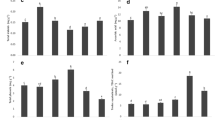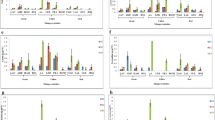Abstract
Tomato is an important agricultural crop world-wide. Their pigments are very important in many ways. They have been associated with health benefits such as lowering the risk of some chronic diseases. Quantification of chlorophylls by spectrophotometry and Identification of carotenoids using liquid chromatography coupled to mass spectrometry, and quantification by HPLC-DAD was carried out in the exocarp and mesocarp of tomato fruit during 6 different ripeness stages (mature-green, breakers, turning, pink, light-red and red). Four carotenoids have been followed during ripening; β-carotene and lycopene were unequivocally identified, whereas γ-carotene and lycopene-epoxide were tentatively identified. Differences between exocarp and mesocarp were as follows: Most of the ripening period, fruit exocarp had higher quantities of both chlorophyll and carotenoids than mesocarp. In both, exocarp and mesocarp, chlorophylls drastically decreased, lycopene significantly increased, while β-carotene, γ-carotene and lycopene-epoxide only increased slightly during fruit ripening.




Similar content being viewed by others
References
Abushita AA, Daood HG, Biacs PA (2000) Change in carotenoids and antioxidant vitamins in tomato as a function of varietal and technological factors. J Agric Food Chem 48:2075–2081
Arab L, Steck S (2000) Lycopene and cardiovascular disease. Am J Clin Nutr 71:1691S–1695S
Association of Official Analytical Chemists, AOAC (1997). Official Methods of Analysis of the Association of Analytical Chemists International. 16th ed. 3rd Revision, Method 940.03, Chlorophyll in Plants. AOAC International, Arlington, VA.
Association of Official Analytical Chemists, AOAC (2000). Official methods of analysis of the association of analytical chemists International, 17th edn. Method 970.64, Vitamin and other nutrient. AOAC International, Gaithersburg.
Barret DM, García E, Wayne JE (1998) Textural modification of processing tomatoes. Crit Rev Food Sci 38:173–258
Bhullar JK, Sogi DS (2000) Shelf life studies and refining of tomato seed oil. J Food Sci Technol 37:542–544
Bramley PM (2000) Is lycopene beneficial to human health? Phytochemistry 54:233–236
Burri BJ (1997) Beta-carotene and human health: a review of current research. Nutr Rev 17:547–580
Calvo MM, García ML, Selgas MD (2008) Dry fermented sausages enriched with lycopene from tomato peel. Meat Sci 80:167–172
Clinton SK, Emenhiser C, Schwartz SJ, Bostwick DG, Williams AW, Moore BJ, Erdmand JW (1996) Cis-trans lycopene isomers, carotenoids and retinol in the human prostate. Cancer Epidemiol Biomarkers 5:823–833
Erdman JW Jr, Rusell RM, Rock CL, Barua AB, Bowen PE, Burri BJ, Curran-Celentano J, Furr H, Mayne ST, Stacewicz-Sapuntzackis M (1996) Beta-carotene and the carotenoids: beyond the intervention trials. Nutr Rev 54:185–188
Flügel M, Gross J (1982) Pigment and plastid changes in mesocarp and exocarp of ripening muskmelon Cucumis melo cv. Galia. J Appl Bot-Angew Bot 56:393–406
Gerster H (1997) The potential role of lycopene for human health. J Am Coll Nutr 16:109–126
Giovanelli G, Lavelli V, Peri C, Novilli S (1999) Variation in antioxidant components of tomato during vine and post-harvest ripening. J Sci Food Agric 79:1583–1588
Hobson G, Davies J (1971) The tomato. In: Hulme A (ed) The biochemistry of fruits and their products vol 2. Academic, Norwich, pp 453–457
Huyskens S, Timberg R, Gross J (1985) Pigment and plastid ultra-structural changes in kumquat (Fortunellamargarita) “Nagami” during ripening. J Plant Physiol 118:61–72
Kader AA, Stevens MA, Albright-Holton M, Morris LL, Algazi M (1977) Effect of fruit ripeness when picked on flavor and composition in fresh market tomatoes. J Am Soc Hortic Sci 113:724–731
Khachick F, Carvalho L, Bernstein PS, Muir GJ, Zhao DY, Katz NB (2002) Chemistry, distribution and metabolism of tomato carotenoids and their impact on human health. Exp Biol Med 227:845–851
Khachick F, Goli MB, Beecher GR, Holden J, Lusby WR, Tenorio MD, Barrera MR (1992) Effect of food preparation on qualitative and quantitative distribution of major carotenoid constituents of tomatoes and several green vegetables. J Agric Food Chem 40:390–398
Kozukue N, Friedman M (2003) Tomatine, chlorophyll, β-carotene and lycopene content in tomatoes during growth and maturation. J Sci Food Agric 83:195–200
Rodriguez-Amaya DB (2000) A guide to carotenoid analysis in food. ILSI Press, Washington
Sogi DS, Kiran J, Bawa AS (1999) Characterization and utilization of tomato seed oil from tomato processing waste. J Food Sci Technol 36:248–249
Soto-Zamora G, Yahia EM, Brecht JK, Gardea A (2005) Effects of postharvest hot air treatments on the quality and antioxidant levels in tomato fruit. Lebensm Wiss Technol 38:657–663
Stahl W, Sies H (1996) Perspective in biochemistry and biophysics. Lycopene. A biologically important carotenoid for humans. Arch Biochem Biophys 336:1–9
Watada AE, Aulenbach AA (1979) Chemical and sensory qualities of fresh market tomatoes. J Food Sci 44:1013–1016
Yahia EM, Soto-Zamora G, Brecht JK, Gardea A (2007) Postharvest hot air treatment effects on the antioxidant system in stored mature-green tomatoes. Postharvest Biol Technol 44:107–115
Acknowledgements
Authors are grateful to Roberto Gutierrez-Dorado for his statistical analysis assistance.
Author information
Authors and Affiliations
Corresponding author
Rights and permissions
About this article
Cite this article
Carrillo-López, A., Yahia, E.M. Changes in color-related compounds in tomato fruit exocarp and mesocarp during ripening using HPLC-APcI+-mass Spectrometry. J Food Sci Technol 51, 2720–2726 (2014). https://doi.org/10.1007/s13197-012-0782-0
Revised:
Accepted:
Published:
Issue Date:
DOI: https://doi.org/10.1007/s13197-012-0782-0




